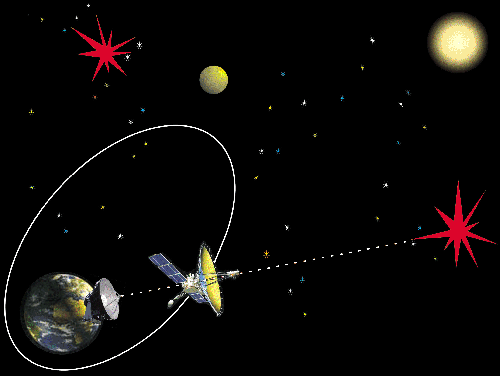
Orbit
Click here

The orbit of the RadioAstron provides four types of study:
For this an orbit was chosen with high apogee and with period of satellite rotation around the Earth of about 9.5 days, which evolves as a result of weak gravitational perturbations from the Moon and the Sun. The perigee radius varies from 10 to 70 thousand kilometers, the apogee radius - from 310 to 390 thousand kilometers. The main orbit evolution is in the rotation of its plane around a weakly evolving apsides axis. The normal to the orbital plane traces an oval on the celestial sphere with the major axis about 150 degrees, and minor axis about 40 degrees, in about 3 years. The linear parameters of the orbit vary with a period of about 1.5 years, and angular parameters - with a period about 3 years.
Because of orbit evolution about 80% of radio sources will be located on the sky close to the orbit plane projection at some time intervals, i.e. for such radio sources both very large and small baseline projections will provide possibility to make good images with high and moderate angular resolution. The rest 20% of radio sources can be observed only with high angular resolution.
The mean orbital parameters are given in Table 2.
Table 2
| Period | p = 9.5 days (7 - 10 days) |
| Semi-major axis | a = 189 000 km |
| Inclination | 51.6o |
| Perigee arise due to evolution | from 300 km up to 70*103 km |
A detailed calculation of the high-apogee evolving orbit can be done if the exact time of launch is known.
Number of the SRT re-pointing per day is not more than 10.
After several years of observations, based on the results of conducted studies, it is possible to consider a transfer on a still higher orbit (with apogee radius about 3.2 million km), by additional spacecraft maneuver using gravitational force of the Moon, and using 64-70 m antennas for the spacecraft control, synchronization and reception of telemetry.
The fringe sizes (in micro arc seconds) for the apogee of the above-mentioned orbit and for all RadioAstron bands are given in Table 3.
Table 3
| Bmax (km) | Band / l (cm) | |||
| P / 92 | L / 18 | C / 6.2 | K / 1.35 | |
| l / Bmax (mas) | ||||
| 350 000 | 540 | 106 | 37 | 8 |
| 3 200 000 | 59 | 12 | 4 | 0.9 |